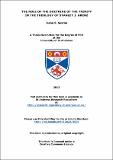Files in this item
The role of the doctrine of the Trinity in the theology of Stanley J. Grenz
Item metadata
| dc.contributor.advisor | Holmes, Stephen R. | |
| dc.contributor.author | Sexton, Jason S. | |
| dc.coverage.spatial | 224 | en_US |
| dc.date.accessioned | 2012-07-26T09:02:21Z | |
| dc.date.available | 2012-07-26T09:02:21Z | |
| dc.date.issued | 2012-03-16 | |
| dc.identifier | uk.bl.ethos.555594 | |
| dc.identifier | uk.bl.ethos.555594 | |
| dc.identifier.uri | https://hdl.handle.net/10023/3025 | |
| dc.description.abstract | This thesis provides an examination into the primary features in the theology of one of the turn of the century’s leading evangelical theologians, Stanley J. Grenz. It begins by establishing the controversial nature of Grenz’s project within evangelical theology, and how his aims were misread by a number of evangelical scholars. It then argues that the primary feature in his writings was the doctrine of the Trinity, giving shape to his methodology, theology, and ethical engagement. Accordingly, this thesis identifies the most significant features he adopted and adapted from Wolfhart Pannenberg, whose influence on Grenz is readily seen. These features include not only how Grenz derived particular methodological aspects from Pannenberg (chap. 2), but also those related to the shape of his trinitarian theology itself (chap. 3). Next, while realizing that Grenz’s new-found emphasis on a trinitarian project was not placed on a tabula rasa, a wider account of his trinitarian background is considered (chap. 4), as is the particular developmental shape of his doctrine of the Trinity itself (chap. 5). Following this, an examination is made into how Grenz accessed this doctrine of the Trinity, through the imago Dei concept, informed by a theological hermeneutic, theological exegesis, and weaved through the traditional systematic loci (chap. 6). Finally, the shape of his trinitarian ethical work is considered in light of the overall coherence of his body of writings, both in its early form as a Christian ethic as well as in the test-cases that were part of his engagement (chap. 7). This is followed by a summary of the reception of Grenz’s project, which is deemed consistent with his aims of being both a distinctly evangelical and trinitarian theologian. | en_US |
| dc.language.iso | en | en_US |
| dc.publisher | University of St Andrews | |
| dc.rights | Creative Commons Attribution-NonCommercial-NoDerivs 3.0 Unported | |
| dc.rights.uri | http://creativecommons.org/licenses/by-nc-nd/3.0/ | |
| dc.subject | Trinity | en_US |
| dc.subject | Stanley J. Grenz | en_US |
| dc.subject | Trinitarian theology | en_US |
| dc.subject | Evangelical theology | en_US |
| dc.subject | Imago Dei | en_US |
| dc.subject | Wolfhart Pannenberg | en_US |
| dc.subject | Systematic theology | en_US |
| dc.subject | Theology | en_US |
| dc.subject.lcc | BX4827.G74S4 | |
| dc.subject.lcsh | Grenz, Stanley J. (Stanley James), 1950-2005 | en_US |
| dc.subject.lcsh | Trinity--History of doctrines--20th century | en_US |
| dc.title | The role of the doctrine of the Trinity in the theology of Stanley J. Grenz | en_US |
| dc.type | Thesis | en_US |
| dc.type.qualificationlevel | Doctoral | en_US |
| dc.type.qualificationname | PhD Doctor of Philosophy | en_US |
| dc.publisher.institution | The University of St Andrews | en_US |
This item appears in the following Collection(s)
Except where otherwise noted within the work, this item's licence for re-use is described as Creative Commons Attribution-NonCommercial-NoDerivs 3.0 Unported
Items in the St Andrews Research Repository are protected by copyright, with all rights reserved, unless otherwise indicated.


